With the spring of 2021 just around the corner, the Irish Farmers Journal met Tipperary dairy farmer Sean T O’Connor to chat about the new calf-rearing facilities he built in November 2019.
Sean is milking 80 dairy cows at Sandymount, just outside Tipperary town. The new calf shed was built with the aim of reducing labour and improving calf health.
He is now heading into his second season using the shed. When setting out to build it, Sean spoke with other farmers and his local veterinary practice.
The shed was built to house 50 calves. It is divided into five large pens holding seven to eight calves each and complies with recommended guidelines allowing 1.7m2 to 2m² lying space per calf.
There are also 10 individual calf pens to cater for newborn calves in the first day or two of life.
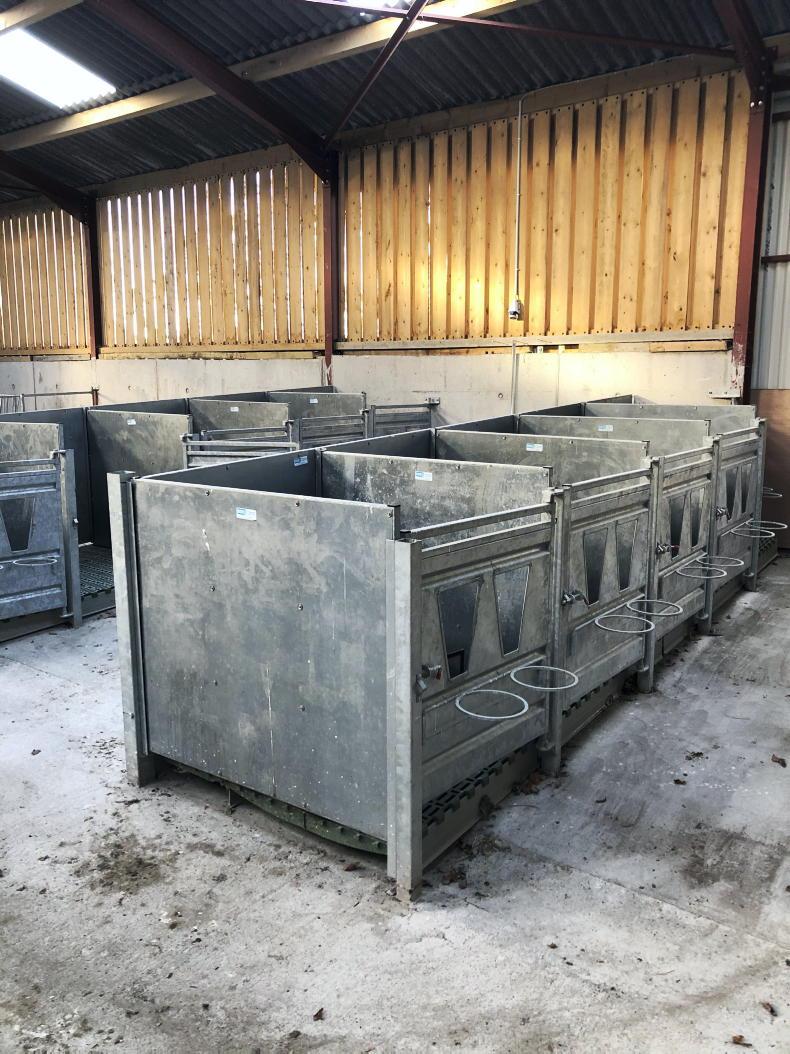
There are 10 individual calf pens
Up to 2019, calves were reared in a lean-to shed and an old cubicle house modified and converted to house 40-50 calves.
Local company O’Dwyer Steel in Dundrum erected the 55ft long by 40ft wide shed. It was kitted out internally by O’Donnell Engineering, which is based in Emly, Co Tipperary.
The shed layout consists of an 8ft central passage with three group pens on one side and a further two group pens on the other, along with the 10 individual calf pens.
The shed is primarily used for rearing heifer calves, with the existing lean-to calf facilities used for housing bull calves.
Once calves are two to three days old and drinking well from an individual teat feeder, they are moved into the larger group pens.
Calves remain in the same group pens until weaning, to avoid mixing calves of different ages, which Sean says could increase the risk of disease spreading.
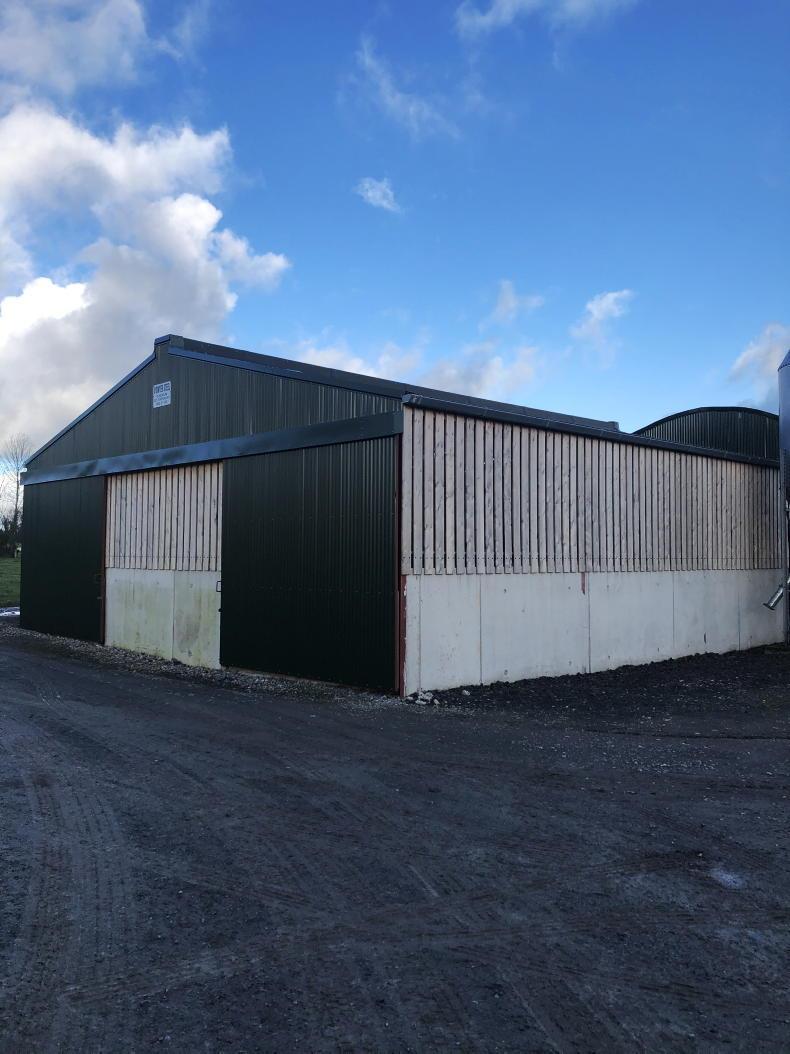
Sean T O'Connor's calf shed.
The back section of each pen is bedded with fresh straw daily and the front section (around 5ft from the gate) is kept as a clean concrete standing/feeding area.
A length of timber was used to create a separation between the straw-bedded area and the concrete standing area.
Sean pointed out the importance of keeping this timber slightly raised off the ground, to allow moisture from the straw bed to drain freely.
His vet advised him that timber has a tendency to soak up moisture and can hold on to bugs such as crypto.
It is tricky to properly clean timber, so Sean was advised to keep it raised and power-hose and disinfect it at the end of each calving season.
The diagonal feed barrier at the front of each pen allows calves access to calf starter ration, while reducing the chances of the meal being contaminated with dung or urine.
The calves are also fed straw. Water troughs are located at the front of each pen. This avoids any leaks or spillages wetting the straw bed and makes them convenient to monitor and clean out.
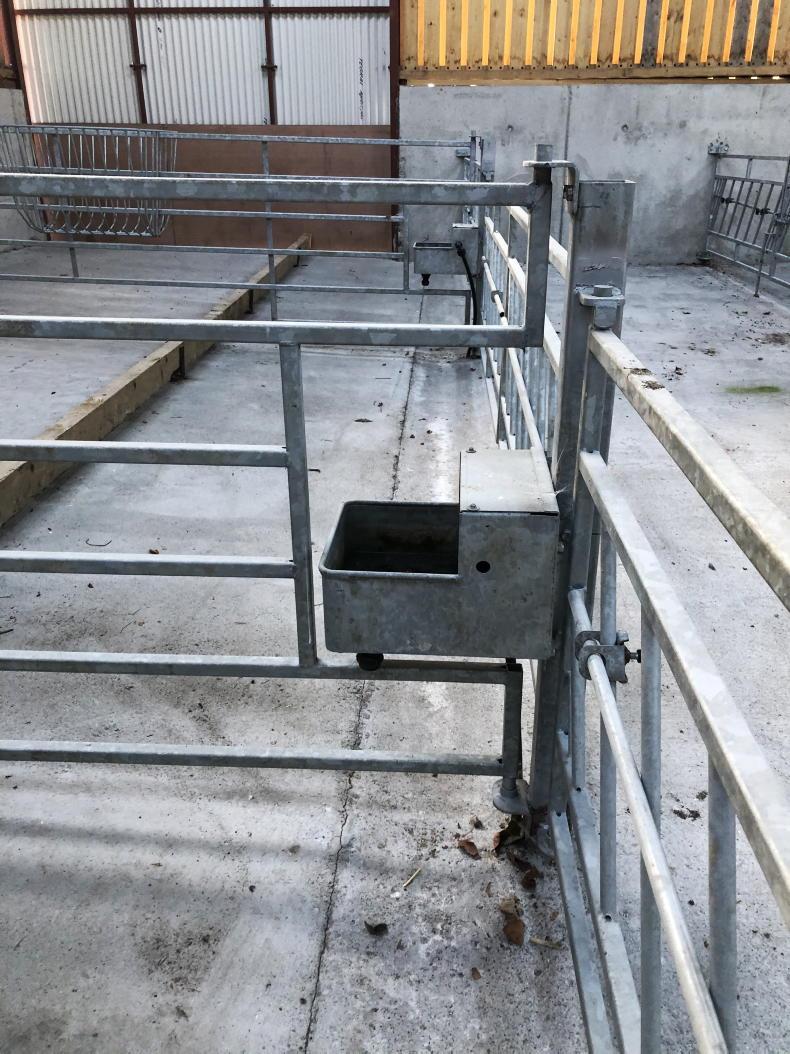
Water troughs at the front of each pen.
Temperature – Due to the nature of the materials used to build calf sheds (concrete and steel), it can be tricky to get the balance right.
Young calves less than three weeks of age will struggle to thrive in temperatures less than 15°C. In Ireland, temperatures will be well below this during the spring.
The inclusion of multiple power sockets throughout the shed allows Sean to create micro-environments with red lamps for young or sick calves, or if outside temperatures drop very low.
Sean has a thermometer in the shed, which he uses to monitor the temperature and will switch the red lamps on and off accordingly.
Moisture – Excess moisture in a shed will drag down the overall temperature. Sean avoids washing feeders and other equipment in the calf shed, as this would further increase the moisture level.
He says he scrapes down the feeding area of each pen, which improves drainage from the straw area. A 1:20 fall in the floor of the calf pens promotes active drainage from the straw beds.
The fast removal of this moisture from the environment reduces the odours in the shed.
A gully runs along the front of each of the pens to collect this runoff, and it is directed into the tank of an adjoining shed.
Air speed – Draughts in a calf shed can be detrimental to calf health and thrive. Ensuring there are no draughts at calf level is key, especially around doors and breaks in the concrete structure of the shed. Getting down to calf level is the only proper way to assess whether calves have a draft coming in on them.
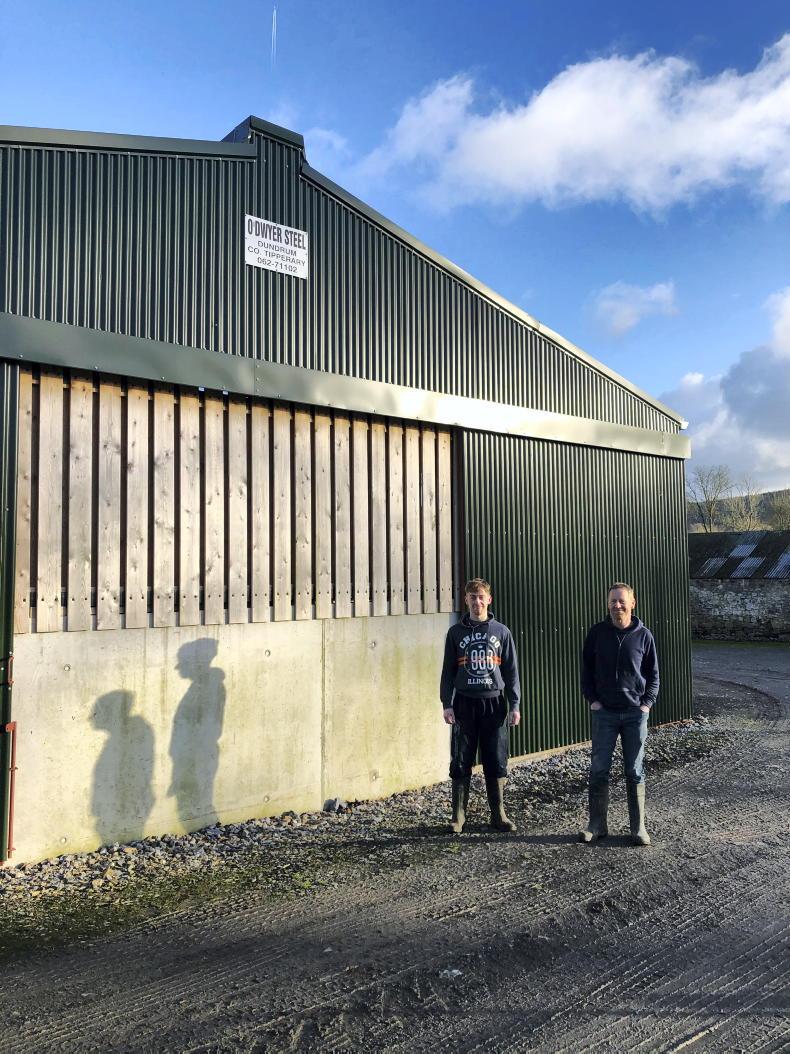
Sean T O'Connor and his son Tadhg outside their new calf shed.
Fresh air and light – Young calves do not produce a lot of body heat – definitely not enough to rise air and create a stack effect like older cattle do.
Therefore, providing fresh air in a calf shed can be quite difficult. Sean thought carefully about where to build the shed and the advice he got was to build it on the prevailing wind (southwest) side of the existing sheds. This avoids air from sheds, with older stock being blown across into the calves, which could cause health problems.
Fortunately, Sean had the space to do this and sealed up one gable end of the shed to avoid shared air space between calves and older stock. The walls around the shed are 5ft high with 7ft of Yorkshire boarding overhead, to give plenty of inlet area and allow fresh air to enter the shed.
The Yorkshire boarding is constructed with an internal and external vertical 6in board.
There are 2in between each board and a 1.5in space between the internal and external boards. The air outlet at the apex of the roof is a fibre cement protected ridge, which is said to reduce the incidence of a down draft.
The fibre cement roof helps to better maintain the temperature in the shed when compared to steal corrugated sheeting.
The shed is three and a half spans long and there are eight clear Perspex sheets in the roof, so there is plenty of natural light.
Labour-saving
It was important to Sean that the shed would also save on labour in the spring.
For this reason, the height of the shed was increased during the design phase, to allow the shed to be cleaned out by a tractor. This was a big improvement for Sean and his son Tadhg, as prior to 2020, all cleaning was done by hand.
The large sliding doors at the west end allow easy access for the tractor during cleaning.
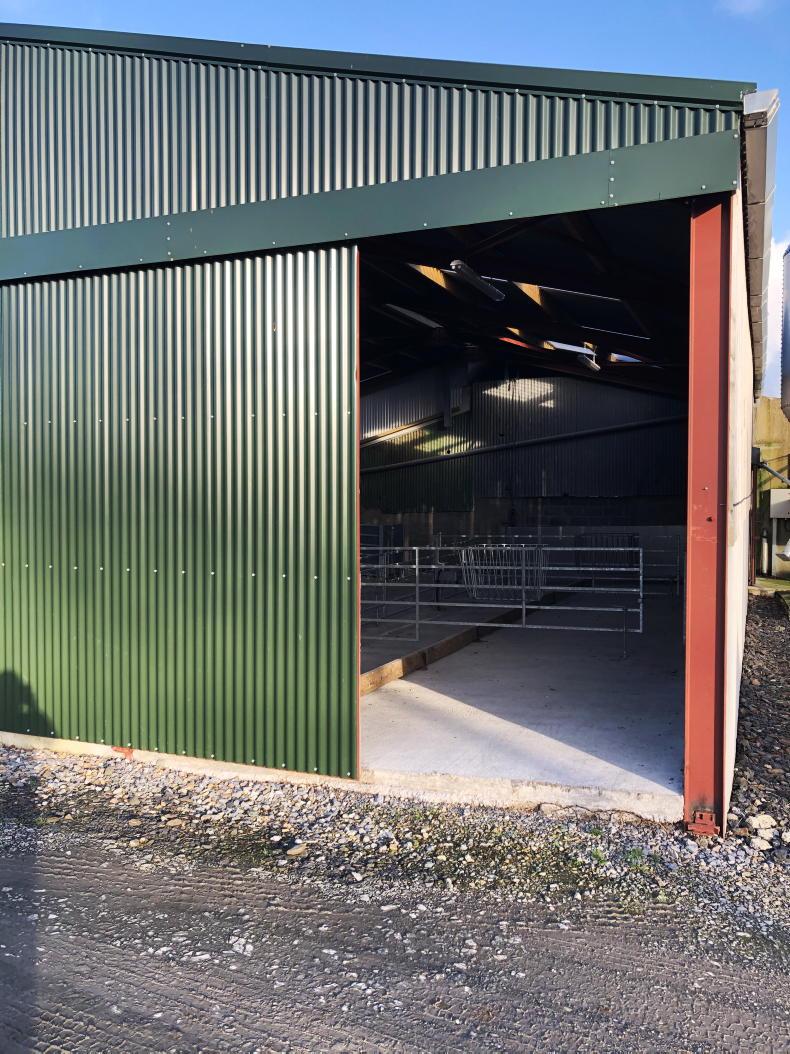
Large sliding doors provide simple access for a tractor to clean out the shed.
Sean said the 1:20 slope reduces the need for a weekly clean-out, as the beds stay dryer for longer, which in turn reduces the amount of straw required.
Calves in groups of seven to eight are fed with a 10-teat feeder and Sean finds this speeds up feeding and allows additional time for monitoring calves and identifying any issues.
Asked about the use of individual pens, as some farmers have moved away from these, Sean said: “We have always had them and I find they work well for getting calves trained, so I’d be slow to move away from them.”
Each new individual pen has calf slats, which are raised a foot from the ground and allow good drainage with less straw required. They are easy to clean throughout the calving season and easily dismantled at the end of the season, when the shed receives a deep clean.

Diagonal rail at the front of each group pen for feeding crunch and hanging teat feeders.
Sean was keen to point out that it is possible to build a much cheaper and lower-spec shed, but he says this was one project he wanted to get right. The overall spend, including the shed, internal fixtures, concrete and labour was €35,000 excluding VAT and Sean did not apply for a grant.
Sean was very happy with calf performance during the spring of 2020 and is hoping for a repeat performance this spring.
While there are few changes he would make, he mentioned having a designated area for clean straw storage within the shed, as well as a concrete apron around the shed, as additions he will consider in the future.
Sean T O’Connor is milking 80 cows and built a new calf shed for 50 heifer calves.The shed is split into five group pens and 10 individual pens.Calves are fed using a 10-teat feeder and the shed can be cleaned out by a tractor.Infrared heat lamps are used during cold weather and to keep young calves warm.
With the spring of 2021 just around the corner, the Irish Farmers Journal met Tipperary dairy farmer Sean T O’Connor to chat about the new calf-rearing facilities he built in November 2019.
Sean is milking 80 dairy cows at Sandymount, just outside Tipperary town. The new calf shed was built with the aim of reducing labour and improving calf health.
He is now heading into his second season using the shed. When setting out to build it, Sean spoke with other farmers and his local veterinary practice.
The shed was built to house 50 calves. It is divided into five large pens holding seven to eight calves each and complies with recommended guidelines allowing 1.7m2 to 2m² lying space per calf.
There are also 10 individual calf pens to cater for newborn calves in the first day or two of life.

There are 10 individual calf pens
Up to 2019, calves were reared in a lean-to shed and an old cubicle house modified and converted to house 40-50 calves.
Local company O’Dwyer Steel in Dundrum erected the 55ft long by 40ft wide shed. It was kitted out internally by O’Donnell Engineering, which is based in Emly, Co Tipperary.
The shed layout consists of an 8ft central passage with three group pens on one side and a further two group pens on the other, along with the 10 individual calf pens.
The shed is primarily used for rearing heifer calves, with the existing lean-to calf facilities used for housing bull calves.
Once calves are two to three days old and drinking well from an individual teat feeder, they are moved into the larger group pens.
Calves remain in the same group pens until weaning, to avoid mixing calves of different ages, which Sean says could increase the risk of disease spreading.

Sean T O'Connor's calf shed.
The back section of each pen is bedded with fresh straw daily and the front section (around 5ft from the gate) is kept as a clean concrete standing/feeding area.
A length of timber was used to create a separation between the straw-bedded area and the concrete standing area.
Sean pointed out the importance of keeping this timber slightly raised off the ground, to allow moisture from the straw bed to drain freely.
His vet advised him that timber has a tendency to soak up moisture and can hold on to bugs such as crypto.
It is tricky to properly clean timber, so Sean was advised to keep it raised and power-hose and disinfect it at the end of each calving season.
The diagonal feed barrier at the front of each pen allows calves access to calf starter ration, while reducing the chances of the meal being contaminated with dung or urine.
The calves are also fed straw. Water troughs are located at the front of each pen. This avoids any leaks or spillages wetting the straw bed and makes them convenient to monitor and clean out.

Water troughs at the front of each pen.
Temperature – Due to the nature of the materials used to build calf sheds (concrete and steel), it can be tricky to get the balance right.
Young calves less than three weeks of age will struggle to thrive in temperatures less than 15°C. In Ireland, temperatures will be well below this during the spring.
The inclusion of multiple power sockets throughout the shed allows Sean to create micro-environments with red lamps for young or sick calves, or if outside temperatures drop very low.
Sean has a thermometer in the shed, which he uses to monitor the temperature and will switch the red lamps on and off accordingly.
Moisture – Excess moisture in a shed will drag down the overall temperature. Sean avoids washing feeders and other equipment in the calf shed, as this would further increase the moisture level.
He says he scrapes down the feeding area of each pen, which improves drainage from the straw area. A 1:20 fall in the floor of the calf pens promotes active drainage from the straw beds.
The fast removal of this moisture from the environment reduces the odours in the shed.
A gully runs along the front of each of the pens to collect this runoff, and it is directed into the tank of an adjoining shed.
Air speed – Draughts in a calf shed can be detrimental to calf health and thrive. Ensuring there are no draughts at calf level is key, especially around doors and breaks in the concrete structure of the shed. Getting down to calf level is the only proper way to assess whether calves have a draft coming in on them.

Sean T O'Connor and his son Tadhg outside their new calf shed.
Fresh air and light – Young calves do not produce a lot of body heat – definitely not enough to rise air and create a stack effect like older cattle do.
Therefore, providing fresh air in a calf shed can be quite difficult. Sean thought carefully about where to build the shed and the advice he got was to build it on the prevailing wind (southwest) side of the existing sheds. This avoids air from sheds, with older stock being blown across into the calves, which could cause health problems.
Fortunately, Sean had the space to do this and sealed up one gable end of the shed to avoid shared air space between calves and older stock. The walls around the shed are 5ft high with 7ft of Yorkshire boarding overhead, to give plenty of inlet area and allow fresh air to enter the shed.
The Yorkshire boarding is constructed with an internal and external vertical 6in board.
There are 2in between each board and a 1.5in space between the internal and external boards. The air outlet at the apex of the roof is a fibre cement protected ridge, which is said to reduce the incidence of a down draft.
The fibre cement roof helps to better maintain the temperature in the shed when compared to steal corrugated sheeting.
The shed is three and a half spans long and there are eight clear Perspex sheets in the roof, so there is plenty of natural light.
Labour-saving
It was important to Sean that the shed would also save on labour in the spring.
For this reason, the height of the shed was increased during the design phase, to allow the shed to be cleaned out by a tractor. This was a big improvement for Sean and his son Tadhg, as prior to 2020, all cleaning was done by hand.
The large sliding doors at the west end allow easy access for the tractor during cleaning.

Large sliding doors provide simple access for a tractor to clean out the shed.
Sean said the 1:20 slope reduces the need for a weekly clean-out, as the beds stay dryer for longer, which in turn reduces the amount of straw required.
Calves in groups of seven to eight are fed with a 10-teat feeder and Sean finds this speeds up feeding and allows additional time for monitoring calves and identifying any issues.
Asked about the use of individual pens, as some farmers have moved away from these, Sean said: “We have always had them and I find they work well for getting calves trained, so I’d be slow to move away from them.”
Each new individual pen has calf slats, which are raised a foot from the ground and allow good drainage with less straw required. They are easy to clean throughout the calving season and easily dismantled at the end of the season, when the shed receives a deep clean.

Diagonal rail at the front of each group pen for feeding crunch and hanging teat feeders.
Sean was keen to point out that it is possible to build a much cheaper and lower-spec shed, but he says this was one project he wanted to get right. The overall spend, including the shed, internal fixtures, concrete and labour was €35,000 excluding VAT and Sean did not apply for a grant.
Sean was very happy with calf performance during the spring of 2020 and is hoping for a repeat performance this spring.
While there are few changes he would make, he mentioned having a designated area for clean straw storage within the shed, as well as a concrete apron around the shed, as additions he will consider in the future.
Sean T O’Connor is milking 80 cows and built a new calf shed for 50 heifer calves.The shed is split into five group pens and 10 individual pens.Calves are fed using a 10-teat feeder and the shed can be cleaned out by a tractor.Infrared heat lamps are used during cold weather and to keep young calves warm. 











 This is a subscriber-only article
This is a subscriber-only article











SHARING OPTIONS: